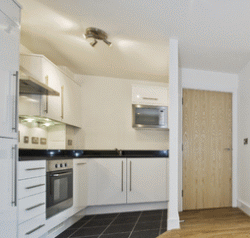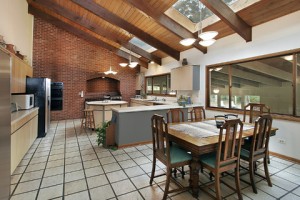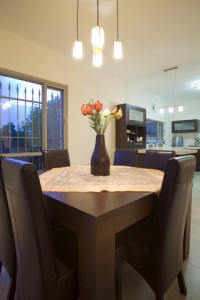Kitchen Ceiling Lighting: Integrating Your Kitchen Space
Kitchen ceiling lighting provides excellent and well-needed ambient and accent lighting in your kitchen.
Kitchen ceiling lighting is an increasingly important part of our overall lighting design, now that kitchens are increasingly a space for living rather than simply a space for working. Moreover, the introduction of open-concept homes and eating spaces within kitchens has greatly increased the complexity of its design. No longer are we simply lighting one space when lighting a kitchen, but two: there is the food preparation area and the dining nook. In this article, I will discuss how to use kitchen ceiling lighting to balance the needs of these various spaces so that they fulfill their functions while still remaining attractive.
One Room or Two?
The most important question when putting together your kitchen ceiling lighting is whether you want to light your kitchen as though it is one room, two or something in between. Most kitchens have eating areas that need to be lit, not simply as an afterthought, but in their own right. Nonetheless, because the space between the food preparation area and the eating area is so open, the lighting needs to be designed in such a way that your different lighting plans do not interfere with one another.
If you decide to treat your kitchen mostly as a single room, you will by-and-large make your eating area look more like a small eating nook in what is otherwise simply a kitchen. This is not necessarily a bad thing, especially if you use it only for breakfast and lunch. You can have a small amount of separate kitchen ceiling lighting for your eating area, then place the area near a window or glass door and let the sunlight pick up the slack.Integrating a single room where the eating area stands out is somewhat harder, and is better if you plan to use the eating area for dinner. In general, you will want to use contrast to make the areas seem separate. In effect, what you will want to do is have a greater contrast between accent and task lighting, like the eating table and the kitchen countertops, and the ambient lighting in the room. This makes each area seem more like an island.
Food Preparation Area Lighting
As I mentioned in my article on kitchen track lighting, kitchen ceiling lighting is especially bad for any tasks in the kitchen. With a few exceptions, ceiling lighting, at least directed track lighting and recessed lighting fixtures, creates shadows when you actually try to use it. As a result, I suggest that you use under-kitchen-cabinet lighting for as many of your kitchen task lights as possible.

Light shone off of white and off-white surfaces provides overall ambient lighting to your room.
One option is simply to use flush-mounted or pendant kitchen ceiling lights inside of your food preparation area. These simply shine light around your kitchen in various directions, providing overall lighting in the color of your choice, dependent on your light bulb and the color of your shade. While this is can be a very attractive design, there is one large caution here. If you use this method, you should use multiple light sources. As people can look directly at your light source, however diffuse, a single light source will create a “glare bomb”, contracting the pupils and making the room look darker.
A second option is to use pendant lighting, track lighting or over-counter lights that bounce light off of the ceiling. This light is quite soft and looks very good on faces. On the other hand, it picks up the color of your ceiling, so it is best used with off-white surfaces. It has the advantage that no one needs to look into your light source, even if diffuse, and brightens up your entire room. The downside is that you will need to have at least some non-diffuse light, or your kitchen can start to look like a cloudy day.
Finally, there is the question of how to use accent lighting in your food preparation area. The more distinction you want there to be between your eating and food preparation area, the more contrast there should be between the accent and ambient lighting. Accent lighting is lighting that highlights individual objects of interest in a room and can be provided through track lighting systems or even a cable lighting system (if you have an awkward ceiling). Accent lighting can highlight your artwork, your cabinets, your pots and pans and even your refrigerator if you wish. The goal is to choose what in your kitchen you wish to have stand out and thereby shape how people see the space.
Dining Area Lighting
Let’s start with the basic question: what are you planning to use your dining area for? If you are planning to use your dining area only for breakfasts and lunches, you do not need to light your dining area quite as brightly, as light will come in through the windows during those times (note that this might not be true if you eat breakfast early at a northern latitude, as you may be eating breakfast in the dark). If you are planning to use it for dinners (including family dinners), you will need to have kitchen ceiling lighting that can fulfill its task even when there is no sunlight to help you.For lighting the table itself, kitchen pendant lighting is a good option. Even with a small table, however, you should avoid having a single light source, as it will create a glare bomb for the same reasons mentioned above. Instead, use multiple pendants that go the length of your table (if it is oblong and large enough), or that complement the shape of your room while simultaneously going over your tabletop. The multiple angles of light will really bring out people’s faces. If you have an especially large table, you could consider a flush-mounted fixture, but pendants bring the light closer to people’s faces, which is more complementary.
For accent lighting, track lighting can highlight the attractive art and other decorations that you’ve placed within your dining area. You can highlight works of art, family treasures or other objects of interest spread around your room. Again, remember that the greater the contrast between your accent lighting and your ambient lighting, the more your eating area will seem like a separate space. Accent lighting provides a great opportunity for integrating the style of the two parts of your kitchen. You can use the same tracks to provide accent lighting both to your food preparation and dining areas, thereby making your kitchen look like a single entity, if you wish.
Integrating Your Kitchen
How should the lighting from your food preparation area and your dining area interact? In general, you should have them be at approximately the same light level. We are very attentive to contrast, and any significant contrast between the two areas would make the other area look dim. As a result, you should make sure that the two rooms are at approximately the same brightness. Remember that because of stronger task lighting, your food preparation area already has a head start in terms of its brightness. As a result, you’ll need to let your dining area catch up somewhat. Lower levels of accent lighting and ambient lighting in the food preparation can do this, as can brighter ambient lighting in the dining area.
Putting It All Together
Kitchen ceiling lighting allows you to make choices about the relationship of your food preparation area and your dining area:
- You should consider whether you want your kitchen to appear fundamentally as two spaces or one.
- The illusion of separateness can be created by increasing the contrast between accent and other forms of lighting.
- Pendant lighting, flush-mounted lighting and over-cabinet lighting all provide ambient lighting for your food preparation area.
- How much light you need for your dining area depends on whether you plan to use it in the dark.
- Your food preparation and eating areas should be at approximately the same light level.
With all of these tips in mind, you’ll be better able to pick the best kitchen ceiling lighting for your home.
Back from Kitchen Ceiling Lighting to Kitchen Lighting Ideas

